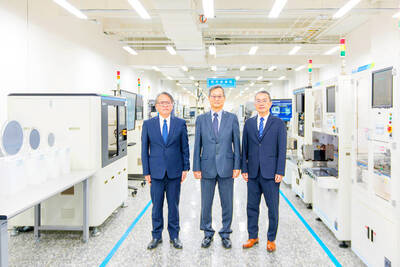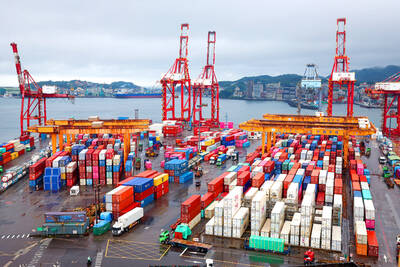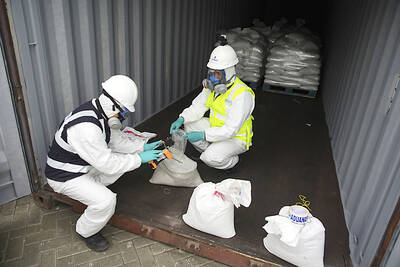Taiwanese manufacturers are suffering greater pain than they had imagined as the economic downturn has severely cut demand for almost all kind of gadgets. They are bracing for a trying year, mainly by taking stringent cost-saving measures and axing capital spending.
The conservative approach, however, may not good enough for ambitious companies hoping to outpace rivals during rough times and not sufficient to help them develop better reflexes to benefit from the first recovery.
“I will suggest companies dig deeper looking for new areas with growth potential. Those are areas easily ignored [in times of prosperity]. And they have to consider [dropping] old tricks,” said Victor Tsan (詹文男), vice president of Taipei-based research house and consultancy Market Intelligence Center (MIC, 產業情報研究所).
It is time to overhaul the commonly seen mindset of expanding shipments to reach economies of scale and then turn the manufacturing business into branding business after they make profits by making products for other firms, Tsan said.
As Taiwanese electronics makers have relied on providing manufacturing services for customers for a long time, they as a whole may post first annual decline in revenues this year since the tech bubble burst in 2001 as demand contracts.
MIC estimates the overall revenues of Taiwanese electronics companies may drop by 5 percent to 6 percent this year from last year.
Semiconductor companies may face even bleaker prospects as the global semiconductor industry is likely to see revenue plunge 30 percent this year from last year, while the contract chipmaking industry, where Taiwanese firms plays a major role, may face even sharper decline, the Hsinchu-based Taiwan Semiconductor Manufacturing Co (TSMC, 台積電) said last week.
On Thursday, TSMC posted its weakest quarterly earnings in about six years in the three months ending Dec. 31, when its profit sank 64 percent to NT$12.45 billion (US$370 million) from a year ago.
The world’s largest contract chipmaker warned it could see its first quarterly loss since 1990 in the current quarter as customers cut orders.
While TSMC said it was mulling cutting capital spending by 20 percent this year from last year’s US$1.88 billion, it still planned to budget about 65 percent of its capital expenditure to developing the most advanced 40-nanometer and 45-nanometer technologies to stay competitive in the long term.
“Although most local firms tend to maintain their status quo during this dark period, they’ve got to take new approaches, or develop new strategies to survive,” Tsan said.
Possible approaches include diversifying into new markets outside the US and Europe and developing products based on newly developed platforms such as smartphones powered by Google Inc’s Android system, or netbooks with built-in TV tuners, he said.
Plans by HTC Corp (宏達電), which has produced the world’s first Google phone, to sell a new own-brand mobile phone in Japan later this year could shed some light on such efforts.
HTC is teaming up with Japan’s No. 2 wireless service carrier KDDI Corp in developing the new phone, code-named E30HT, after it found success in the European markets via working with telecom operators there.
One bright spot is that HTC has made a successful entry into the Japanese market, one of the most difficult markets for foreign mobile phone vendors.
In November, the Finnish giant Nokia announced it would pullout of Japan after its market share there remained limited despite years of efforts.
“Opportunities abound in the times of crisis,” Tsan said.
But only those willing to invest in the future will recover faster and outgrow others, he said
Research powerhouse International Data Corp (IDC) believes there are growing market opportunities that a company can approach even in a downturn.
Alan Tsao (曹永輝), an IDC analyst based in Taipei, said netbook computers, among other mobile devices, would continue to dominate the market this year.
Tsao said prices of netbooks have fallen to an affordable level after Intel Corp launched the inexpensive Atom processor last year. But the beauty of this category of laptops was that they still support a good enough performance with low power consumption, he said.
“We found that some small and medium-sized businesses have begun replacing their desktop PCs with netbooks recently, because they believe netbooks are good enough for them and the price is friendly,” Tsao said.

SMART MANUFACTURING: The company aims to have its production close to the market end, but attracting investment is still a challenge, the firm’s president said Delta Electronics Inc (台達電) yesterday said its long-term global production plan would stay unchanged amid geopolitical and tariff policy uncertainties, citing its diversified global deployment. With operations in Taiwan, Thailand, China, India, Europe and the US, Delta follows a “produce at the market end” strategy and bases its production on customer demand, with major site plans unchanged, Delta president Simon Chang (張訓海) said on the sidelines of a company event yesterday. Thailand would remain Delta’s second headquarters, as stated in its first-quarter earnings conference, with its plant there adopting a full smart manufacturing system, Chang said. Thailand is the firm’s second-largest overseas

‘REMARKABLE SHOWING’: The economy likely grew 5 percent in the first half of the year, although it would likely taper off significantly, TIER economist Gordon Sun said The Taiwan Institute of Economic Research (TIER) yesterday raised Taiwan’s GDP growth forecast for this year to 3.02 percent, citing robust export-driven expansion in the first half that is likely to give way to a notable slowdown later in the year as the front-loading of global shipments fades. The revised projection marks an upward adjustment of 0.11 percentage points from April’s estimate, driven by a surge in exports and corporate inventory buildup ahead of possible US tariff hikes, TIER economist Gordon Sun (孫明德) told a news conference in Taipei. Taiwan’s economy likely grew more than 5 percent in the first six months

SUPPLY RESILIENCE: The extra expense would be worth it, as the US firm is diversifying chip sourcing to avert disruptions similar to the one during the pandemic, the CEO said Advanced Micro Devices Inc (AMD) chief executive officer Lisa Su (蘇姿丰) on Wednesday said that the chips her company gets from supplier Taiwan Semiconductor Manufacturing Co (TSMC, 台積電) would cost more when they are produced in TSMC’s Arizona facilities. Compared with similar parts from factories in Taiwan, the US chips would be “more than 5 percent, but less than 20 percent” in terms of higher costs, she said at an artificial intelligence (AI) event in Washington. AMD expects its first chips from TSMC’s Arizona facilities by the end of the year, Su said. The extra expense is worth it, because the company is

The seizure of one of the largest known mercury shipments in history, moving from mines in Mexico to illegal Amazon gold mining zones, exposes the wide use of the toxic metal in the rainforest, according to authorities. Peru’s customs agency, SUNAT, found 4 tonnes of illegal mercury in Lima’s port district of Callao, according to a report by the non-profit Environmental Investigations Agency (EIA). “This SUNAT intervention has prevented this chemical from having a serious impact on people’s health and the environment, as can be seen in several areas of the country devastated by the illegal use of mercury and illicit activities,”